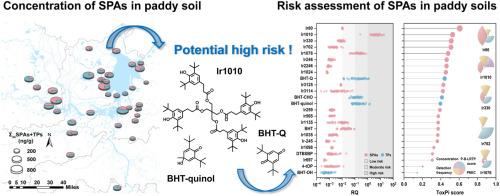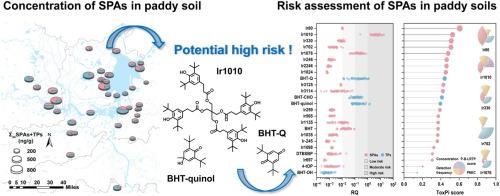Synthetic phenolic antioxidants in paddy soils from central China: Contamination characteristics and risk prioritization analysis
IF 7.3
2区 环境科学与生态学
Q1 ENVIRONMENTAL SCIENCES
引用次数: 0
Abstract
The contamination characteristics and ecological risks of synthetic phenolic antioxidants (SPAs) in agricultural soils remain poorly understood. In this study, 20 SPAs and 4 of their transformation products were analyzed in paddy soils from the Dongting Lake Basin in central China. The median total concentration of the 20 SPAs (Σ20SPAs) was 147 ng/g (range, 27.6–612 ng/g), while their transformation products had a median concentration of 127 ng/g (range, 36.4–625 ng/g). Among the target compounds, pentaerythritol tetrakis(3-(3,5-di-tert-butyl-4-hydroxyphenyl)-propionate) (Ir1010), and 2,6-di-tert-butyl-4-methylphenol (BHT) were identified as the predominant contaminants. Spatial distribution analysis revealed that certain sites in the eastern Dongting Lake Basin exhibited notably higher concentrations of transformation products compared to other areas, indicating potential regional variability in the transformation behavior of SPAs. Furthermore, the detected SPAs and their transformation products posed potential ecological risks to paddy soil ecosystems, with cumulative risk quotient values reaching up to 23.6. The toxicological priority index values of Ir1010 and 2,4,8,10-tetraoxaspiro[5.5]undecane-3,9-diylbis(2-methylpropane-2,1-diyl)bis(3-(3-(tert-butyl)-4-hydroxy-5-methylphenyl)-propanoate) (Ir80) ranked relatively high (0.61 and 0.53, respectively), warranting greater attention. This study provides new insights into the co-occurrence of SPAs and their transformation products in paddy soils, and underscores the complex environmental risks associated with these emerging contaminants.


中国中部水稻土中合成酚类抗氧化剂的污染特征及风险优先级分析
合成酚类抗氧化剂(SPAs)在农业土壤中的污染特征和生态风险尚不清楚。本研究对洞庭湖流域水稻土中20种spa及其4种转化产物进行了分析。20种spa (Σ20SPAs)的中位数总浓度为147 ng/g(范围为27.6-612 ng/g),而其转化产物的中位数浓度为127 ng/g(范围为36.4-625 ng/g)。在目标化合物中,季戊四醇四酯(3-(3,5-二叔丁基-4-羟基苯基)-丙酸酯)(Ir1010)和2,6-二叔丁基-4-甲基苯酚(BHT)是主要污染物。空间分布分析表明,洞庭湖流域东部某些地点的转化产物浓度明显高于其他地区,表明spa转化行为存在潜在的区域差异。检测到的spa及其转化产物对水稻土生态系统存在潜在的生态风险,累积风险商值高达23.6。Ir1010和2,4,8,10-tetraoxaspiro[5.5]十一烷-3,9-二基双(2-甲基丙烷-2,1-二基)双(3-(3-(叔丁基)-4-羟基-5-甲基苯基)-丙酸酯(Ir80)的毒理学优先指数相对较高(分别为0.61和0.53),值得关注。该研究为水稻土中spa及其转化产物的共存提供了新的见解,并强调了与这些新兴污染物相关的复杂环境风险。
本文章由计算机程序翻译,如有差异,请以英文原文为准。
求助全文
约1分钟内获得全文
求助全文
来源期刊

Environmental Pollution
环境科学-环境科学
CiteScore
16.00
自引率
6.70%
发文量
2082
审稿时长
2.9 months
期刊介绍:
Environmental Pollution is an international peer-reviewed journal that publishes high-quality research papers and review articles covering all aspects of environmental pollution and its impacts on ecosystems and human health.
Subject areas include, but are not limited to:
• Sources and occurrences of pollutants that are clearly defined and measured in environmental compartments, food and food-related items, and human bodies;
• Interlinks between contaminant exposure and biological, ecological, and human health effects, including those of climate change;
• Contaminants of emerging concerns (including but not limited to antibiotic resistant microorganisms or genes, microplastics/nanoplastics, electronic wastes, light, and noise) and/or their biological, ecological, or human health effects;
• Laboratory and field studies on the remediation/mitigation of environmental pollution via new techniques and with clear links to biological, ecological, or human health effects;
• Modeling of pollution processes, patterns, or trends that is of clear environmental and/or human health interest;
• New techniques that measure and examine environmental occurrences, transport, behavior, and effects of pollutants within the environment or the laboratory, provided that they can be clearly used to address problems within regional or global environmental compartments.
 求助内容:
求助内容: 应助结果提醒方式:
应助结果提醒方式:


